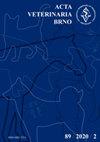The impact of traumatic limb injuries resulting from operations related to transport for slaughter on biochemical indices in end-of-lay hens
IF 0.7
4区 农林科学
Q3 VETERINARY SCIENCES
引用次数: 0
Abstract
The study focused on the welfare of end-of-lay hens during their transportation for slaughter from the viewpoint of the stress load on hens resulting from unsatisfactory treatment that leads to traumatic injury to the limbs of hens detected during the veterinary examination of hens at the slaughterhouse. Blood samples were taken during bleeding after slaughter at the slaughterhouse for the determination of corticosterone and other biochemical indices from 35 hens with traumatic limb injuries and 35 hens without traumatic limb injuries. The stress load during the transportation of hens for slaughter potentiated by traumatic injuries was found to increase (P < 0.01) the plasma corticosterone concentration as an indicator of stress in birds (6381 pg/ml vs. 3681 pg/ml) and affect the plasma concentration of some biochemical indices, in particular increasing (P < 0.05) the level of total protein and albumin and decreasing (P < 0.05) levels of triglycerides, calcium and alanine aminotransferase. These findings demonstrate that hens with traumatic limb injuries occurring during the course of transport (loading, transport, unloading) are burdened by a greater degree of stress than hens that have not suffered traumatic injuries. From the viewpoint of the protection and welfare of end-of-lay hens, this study unequivocally demonstrates the necessity of the corresponding careful handling of birds during their loading onto and unloading from means of transport during transportation to the slaughterhouse – the kind of handling that does not cause injuries and, thereby, an increased stress load on hens slaughtered at the slaughterhouse.屠宰运输相关操作造成的肢体创伤对产蛋鸡末期生化指标的影响
本研究的重点是从对母鸡的应激负荷的角度出发,研究了在屠宰场对母鸡进行兽医检查时发现的由于不满意的处理导致母鸡四肢创伤的母鸡的应激负荷。在屠宰场屠宰后出血时采血,分别取35只肢体外伤鸡和35只肢体非外伤鸡,测定皮质酮等生化指标。结果表明,外伤性肉鸡屠宰运输过程中的应激负荷增加了应激指标血浆皮质酮浓度(6381 pg/ml vs. 3681 pg/ml) (P < 0.01),并影响了一些生化指标的血浆浓度,特别是总蛋白和白蛋白水平升高(P < 0.05),甘油三酯、钙和丙氨酸转氨酶水平降低(P < 0.05)。这些研究结果表明,在运输过程中(装载、运输、卸载)发生创伤性肢体损伤的母鸡比没有遭受创伤性肢体损伤的母鸡承受更大程度的压力。从对产蛋鸡的保护和福利的角度来看,这项研究明确地证明了在运输到屠宰场的运输工具上和从运输工具上卸下禽鸟的过程中,有必要对禽鸟进行相应的小心处理——这种处理不会造成伤害,从而不会增加在屠宰场屠宰的母鸡的压力负荷。
本文章由计算机程序翻译,如有差异,请以英文原文为准。
求助全文
约1分钟内获得全文
求助全文
来源期刊

Acta Veterinaria Brno
农林科学-兽医学
CiteScore
1.00
自引率
33.30%
发文量
36
审稿时长
18-36 weeks
期刊介绍:
ACTA VETERINARIA BRNO is a scientific journal of the University of Veterinary and Pharmaceutical Sciences in Brno, Czech Republic.
The scientific journal Acta Veterinaria Brno is dedicated to the publication of original research findings and clinical observations in veterinary and biomedical sciences. Original scientific research articles reporting new and substantial contribution to veterinary science and original methods that have not been submitted for publication elsewhere are considered for publication. A written statement to this effect should accompany the manuscript, along with approval for publication by the author´s head of department. The authors bear full responsibility for the contents of their contribution. Book reviews are published, too.
 求助内容:
求助内容: 应助结果提醒方式:
应助结果提醒方式:


